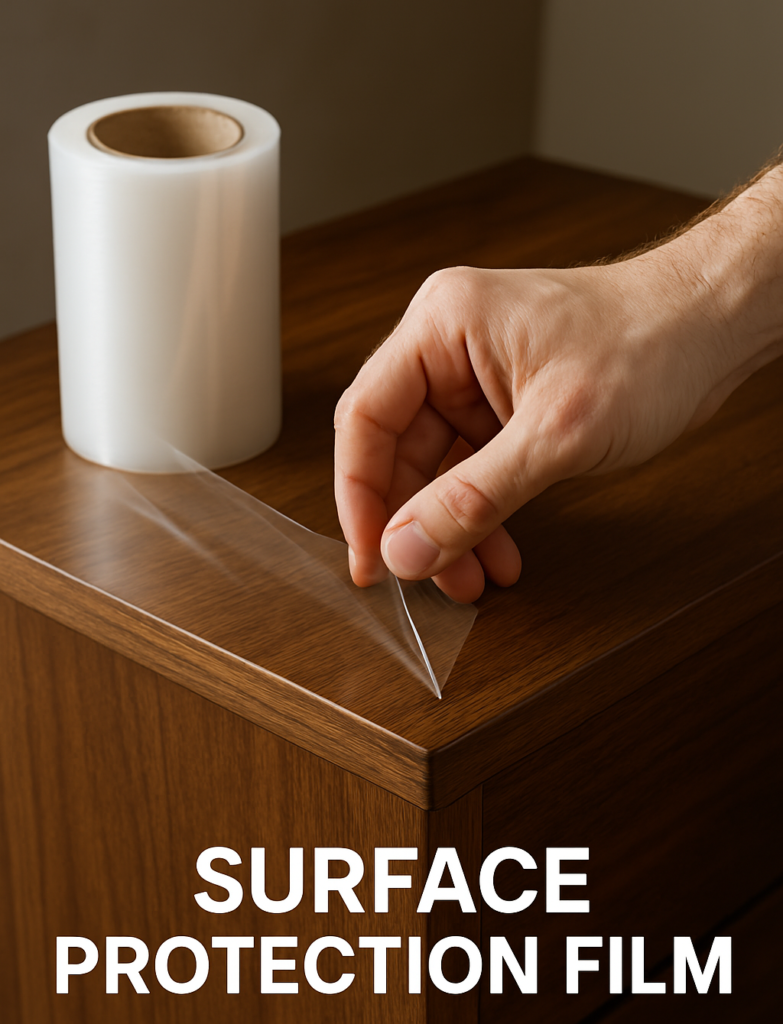When it comes to keeping your products safe during manufacturing, storage, or transport, a surface protection film plays a vital role. From electronics to glass, furniture to metals—protection film helps maintain the look and quality of surfaces by preventing scratches, dust, and other damage.
But with so many types available in the market, how do you choose the best surface protection film? Let us help you to find the best for your products.

Why Use a Protection Film?
A protection film helps keep surfaces safe from damage during manufacturing, storage, handling, or transport. It acts like a shield and protects surfaces from scratches, dust, dirt, stains, and even UV rays.
Here are some key reasons to use a surface protection film:
- Prevents scratches and scuffs
Protects delicate surfaces from tools, handling, or machinery. - Keeps dust and dirt away
Useful during storage or transport to maintain cleanliness - Saves cleaning time and cost
Surfaces stay clean, so there’s less need for rework or polishing. - Maintains product appearance
Products stay in perfect condition when they reach the customer. - Protects from UV and moisture
Some films come with UV resistance and water protection for outdoor use. - Easy to apply and remove
Many protective films feature a simple peel-and-stick design that won’t leave behind any sticky residue.
Picking the Best Surface Protection Film
It’s not one-size-fits-all. You have to pick your perfect match.
1. Know Your Surface
Different surfaces = different needs.
| Surface Type | Recommended Film Type |
| Glass & Mirrors | PE or PET Film |
| Stainless Steel | PE or PVC Film |
| Painted Surfaces | Low-tack Adhesive Film |
| Acrylic & Plastics | Anti static film |
2. Check the Stickiness (Adhesion Strength)
- Low-Tack: For delicate, easy-to-scratch surfaces
- Medium-Tack: Safe for most general surfaces
- High-Tack: For rough, industrial surfaces
3. How Long Will You Use It?
- Short-Term (7–30 days): Basic dust/scratch protection
- Long-Term (up to 12 months): UV and weather resistance
4. Indoor or Outdoor Use?
Choose films based on exposure:
- UV Resistant Films: For sunlight-heavy areas
- Waterproof Films: For humid or outdoor conditions
- Tear-Resistant Films: For rugged environments.
Common Applications of Surface Protection Film
Surface protection films are used in many industries to keep products safe from scratches, dust, and damage. These are the common uses.
- Applied to glass and mirrors to provide scratch protection during shipping and installation.
- Applied to stainless steel surfaces to protect from fingerprints and scuffs.
- Shields plastic sheets and acrylic panels during processing and storage.
- Protects automobile parts like bumpers, doors, and headlights during assembly.
- Covers furniture surfaces to avoid dust and marks before delivery.
- Used on aluminum composite panels (ACP) in construction sites.
- Keeps electronic screens and displays safe from scratches.
- Guards flooring and carpets during renovation or painting work.
Mistakes to Avoid While Buying
❌ Choosing the wrong adhesive strength
❌ Ignoring temperature and UV exposure
❌ Not testing the film before full use
❌ Reusing old or damaged film
Conclusion
Surface protection film: a smart way to save time, money, and headaches. Whether you’re shipping electronics or building a house, the right film can prevent unnecessary damage and help your products look new for longer.
Before making a purchase, always consider your surface type, environment, and duration. Testing a sample is always a smart move.
Looking for Reliable Protection Films?
At Girdhar roll wrap limited, we manufacture and supply high-quality surface protection films suitable for multiple surfaces and industries. Get in touch for free samples and custom orders.
📞 Contact Us: +91 63628 21897
🌐 Website: girdharroll.com
